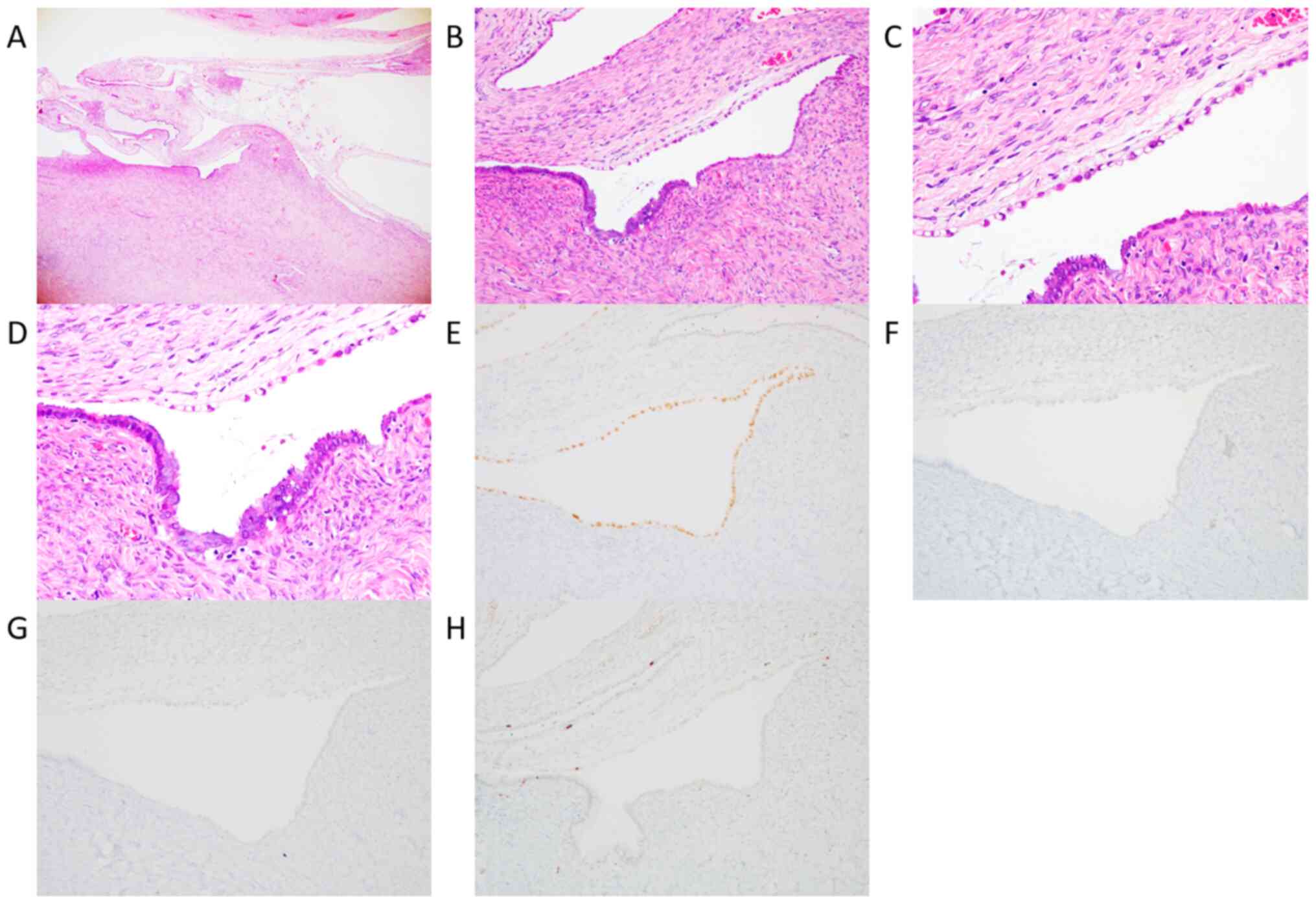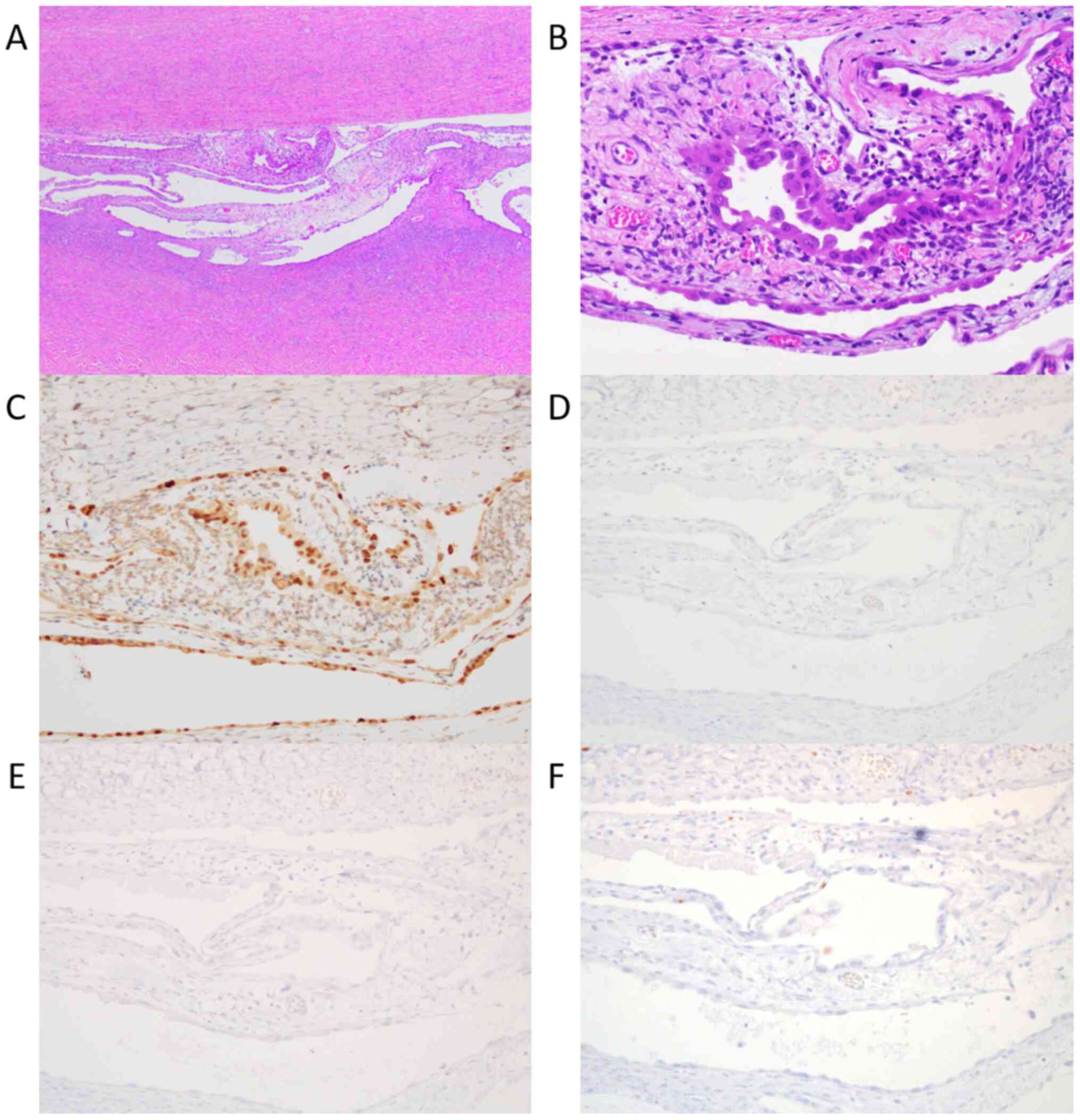|
1
|
Taylor HC Jr: Malignant and semimalignant
tumors of the ovary. Surg Gynecol. 48:204–230. 1929.
|
|
2
|
Classification and staging of malignant
tumours in the female pelvis. Acta Obstet Gynecol Scand 50: 1-7,
1971.
|
|
3
|
Serov SS, Scully RE and Sobin LH (eds);
World Health Organization: Histological Typing of Ovarian Tumors.
Springer, Berlin, Heidelberg, New York, NY, Geneva, 1973.
|
|
4
|
Silverberg SG, Bell DA, Kurman RJ, Seidman
JD, Prat J, Ronnett BM, Copeland L, Silva E, Gorstein F and Young
RH: Borderline ovarian tumors: Key points and workshop summary. Hum
Pathol. 35:910–917. 2004.PubMed/NCBI View Article : Google Scholar
|
|
5
|
Trimble CL, Kosary C and Trimble EL:
Long-term survival and patterns of care in women with ovarian
tumors of low malignant potential. Gynecol Oncol. 86:34–37.
2002.PubMed/NCBI View Article : Google Scholar
|
|
6
|
Lokuhetty D, White VA and Cree IA (eds):
WHO Classification of Tumours of Female Reproductive Organs. Lyon,
IARC, Lyon, 2020.
|
|
7
|
Seidman JD, Soslow RA, Vang R, Berman JJ,
Stoler MH, Sherman ME, Oliva E, Kajdacsy-Balla A, Berman DM and
Copeland LJ: Borderline ovarian tumors: Diverse contemporary
viewpoints on terminology and diagnostic criteria with illustrative
images. Hum Pathol. 35:918–933. 2004.PubMed/NCBI View Article : Google Scholar
|
|
8
|
Suzuki A, Shiozawa T, Mori A, Kimura K and
Konishi I: Cystic clear cell tumor of borderline malignancy of the
ovary lacking fibromatous components: Report of two cases and a
possible new histological subtype. Gynecol Oncol. 101:540–544.
2006.PubMed/NCBI View Article : Google Scholar
|
|
9
|
Pereira A, Pérez-Medina T, Magrina JF,
Magtibay PM, Rodríguez-Tapia A, Peregrin I, Mendizabal E and
Ortiz-Quintana L: International Federation of Gynecology and
Obstetrics staging classification for cancer of the ovary,
fallopian tube, and peritoneum: Estimation of survival in patients
with node-positive epithelial ovarian cancer. Int J Gynecol Cancer.
25:49–54. 2015.PubMed/NCBI View Article : Google Scholar
|
|
10
|
Seidman JD, Soslow RA, Vang R, Berman JJ,
Stoler MH, Sherman ME, Oliva E, Kajdacsy-Balla A, Berman DM and
Copeland LJ: Borderline ovarian tumors: Diverse contemporary
viewpoints on terminology and diagnostic criteria with illustrative
images. Hum Pathol. 35:918–933. 2004.PubMed/NCBI View Article : Google Scholar
|
|
11
|
Hauptmann S, Friedrich K, Redline R and
Avril S: Ovarian borderline tumors in the 2014 WHO classification:
Evolving concepts and diagnostic criteria. Virchows Arch.
470:125–142. 2017.PubMed/NCBI View Article : Google Scholar
|
|
12
|
Ohishi Y, Oda Y, Kurihara S, Kaku T,
Yasunaga M, Nishimura I, Okuma E, Kobayashi H, Wake N and
Tsuneyoshi M: Hobnail-like cells in serous borderline tumor do not
represent concomitant incipient clear cell neoplasms. Hum Pathol.
40:1168–1175. 2009.PubMed/NCBI View Article : Google Scholar
|
|
13
|
Ohishi Y, Kurihara S, Aman M, Takeuchi T,
Imamura H, Kaku T, Kobayashi H, Wake N and Oda Y: ‘Piling up’ clear
cells in müllerian-type mucinous and mixed cell-type borderline
tumor do not represent concomitant clear cell neoplasms. Hum
Pathol. 43:1618–1626. 2012.PubMed/NCBI View Article : Google Scholar
|
|
14
|
Köbel M, Kalloger SE, Boyd N, McKinney S,
Mehl E, Palmer C, Leung S, Bowen NJ, Ionescu DN, Rajput A, et al:
Ovarian carcinoma subtypes are different diseases: Implications for
biomarker studies. PLoS Med. 5(e232)2008.PubMed/NCBI View Article : Google Scholar
|
|
15
|
Kato N, Sasou S and Motoyama T: Expression
of hepatocyte nuclear factor-1beta (HNF-1beta) in clear cell tumors
and endometriosis of the ovary. Mod Pathol. 19:83–89.
2006.PubMed/NCBI View Article : Google Scholar
|
|
16
|
Kao GF and Norris HJ: Unusual
cytadenofibromas: Endometrioid, mucinous, and clear cell types.
Obstet Gynecol. 54:729–736. 1979.PubMed/NCBI
|
|
17
|
Roth LM, Langley FA, Fox H, Wheeler JE and
Czernobilsky B: Ovarian clear cell adenofibromatous tumors. Benign,
of low malignant potential, and associated with invasive clear cell
carcinoma. Cancer. 53:1156–1163. 1984.PubMed/NCBI View Article : Google Scholar
|
|
18
|
Bell DA and Scully RE: Benign and
borderline clear cell adenofibromas of the ovary. Cancer.
56:2922–2931. 1985.PubMed/NCBI View Article : Google Scholar
|
|
19
|
Katsube Y, Fujiwara H, Tanioka Y, Imajo M
and Fujiwara A: Ovarian clear cell adenofibroma of borderline
malignancy. A case report. Hiroshima J Med Sci. 38:87–90.
1989.PubMed/NCBI
|
|
20
|
Liu JL, Chu PY, Yeh KT and Huang RH:
Borderline clear cell adenofibroma with extensive hemorrhagic
necrosis. Hematol Oncol Stem Ther. 3:158–160. 2010.PubMed/NCBI View Article : Google Scholar
|
|
21
|
Momotani K, Tnaka T, Iwai E, Kanda T,
Munakata S and Ohmichi M: Ovarian clear cell adenofibromatous tumor
of borderline malignancy associated with high levels of
carbohydrate antigen 9-9. J Obstet Gynaecol Res. 37:472–477.
2011.PubMed/NCBI View Article : Google Scholar
|
|
22
|
Zhao C, Wu LS and Barner R: Pathogenesis
of ovarian clear cell adenofibroma, atypical proliferative
(borderline) tumor, and carcinoma: Clinicopathologic features of
tumors with endometriosis or adenofibromatous components support
two related pathways of tumor development. J Cancer. 2:94–103.
2011.PubMed/NCBI View
Article : Google Scholar
|
|
23
|
Cakir E, Aydin E, Durmus NI, Samdanci E,
Sahin N and Nurkabul Z: Primary ovarian clear cell adenofibroma of
borderline malignancy. Oman Med J. 27(e031)2012.PubMed/NCBI View Article : Google Scholar
|
|
24
|
Vasilakaki T, Skafida E, Arkoumani E,
Grammatoglou X, Firfiris N and Manoloudaki K: Borderline clear cell
adenofibroma of the ovary associated with ovarian endometriosis: A
case report. Eur J Gynarcol Oncol. 33:230–232. 2012.PubMed/NCBI
|
|
25
|
Uzan C, Dufeu-Lefebvre M, Fauvet R, Gouy
S, Duvillard P, Darai E and Morice P: Management and prognosis of
clear cell borderline ovarian tumor. Int J Gynecol Cancer.
22:993–999. 2012.PubMed/NCBI View Article : Google Scholar
|
|
26
|
Kleebkaow P, Aue-Aungkul A,
Temtanakitpaisan A and Kietpeerakool C: Borderline clear cell
adenofibroma of the ovary. Case Rep Pathol.
2017(3860107)2017.PubMed/NCBI View Article : Google Scholar
|
















